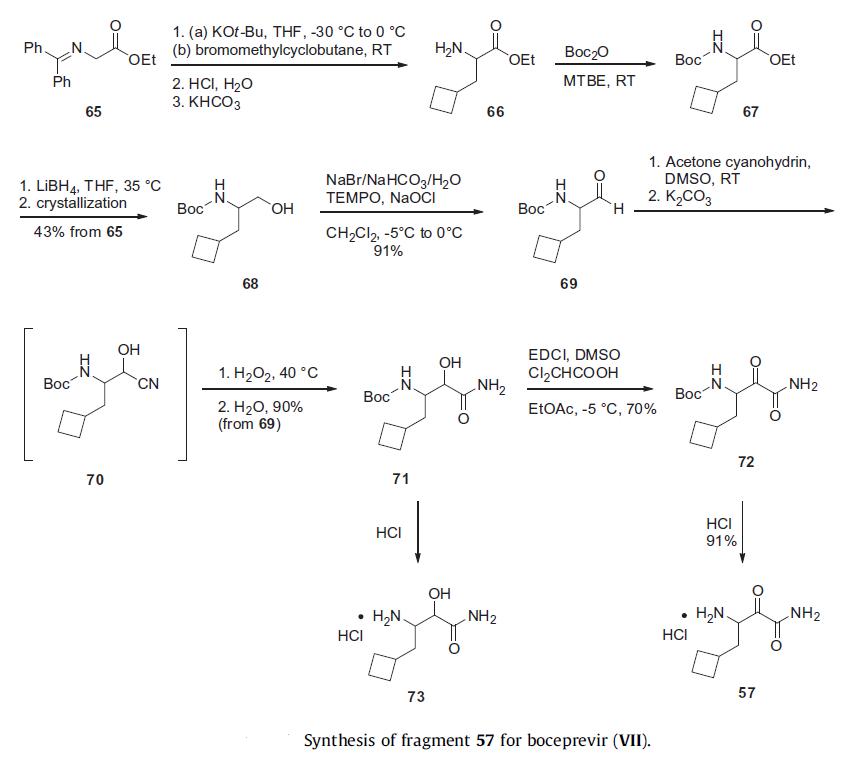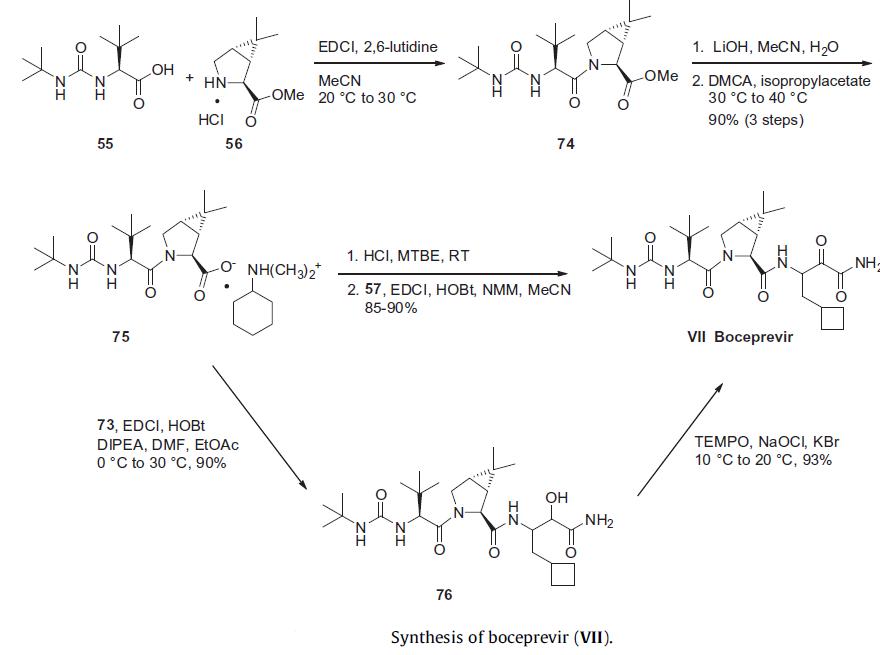| Identification | Back Directory | [Name]
Boceprevir | [CAS]
394730-60-0 | [Synonyms]
CS-354
EBP 520
Sch 503034
Boceprevir
Bocepravir
Boceprevir, >=98%
Boceprevir(EBP 520
Boceprevir USP/EP/BP
Boceprevir(Sch 503034)
TIANFUCHEM-- Boceprevir
Boceprevir (10mM in DMSO)
Boceprevir/EBP520/Sch503034
EBP 520;SCH 503034;EBP-520;EBP520;SCH-503034;SCH503034)
(1R,2S,5S)-N-(4-aMino-1-cyclobutyl-3,4-dioxobutan-2-yl)-3-((S)-2-(3-(tert-butyl)ureido)-3,3-diMethylbutanoyl)-6,6-diMethyl-3-azabicyclo[3.1.0]hexane-2-carboxaMide
BoceprevirQ: What is
Boceprevir Q: What is the CAS Number of
Boceprevir Q: What is the storage condition of
Boceprevir Q: What are the applications of
Boceprevir
(1R,2S,5S)-N-(4-Amino-1-cyclobutyl-3,4-dioxobutan-2-yl)-3-[(2S)-2-(tert-butylcarbamoylamino)-3,3-dimethylbutanoyl]-6,6-dimethyl-3-azabicyclo[3.1.0]hexane-2-carboxamide
Boceprevir
(1R,2S,5S)-N-(4-Amino-1-cyclobutyl-3,4-dioxobutan-2-yl)-3-[(2S)-2-(tert-butylcarbamoylamino)-3,3-dimethylbutanoyl]-6,6-dimethyl-3-azabicyclo[3.1.0]hexane-2-carboxamide
(1R,2S,5S)-N-[3-AMino-1-(cyclobutylMethyl)-2,3-dioxopropyl]-3-[(2S)-2-[[[(1,1-diMethylethyl)aMino]carbonyl]aMino]-3,3-diMethyl-1-oxobutyl]-6,6-diMethyl-3-azabicyclo[3.1.0]hexane-2-carboxaMide
3-Azabicyclo[3.1.0]hexane-2-carboxaMide, N-[3-aMino-1-(cyclobutylMethyl)-2,3-dioxopropyl]-3-[(2S)-2-[[[(1,1-diMethylethyl)aMino]carbonyl]aMino]-3,3-diMethyl-1-oxobutyl]-6,6-diMethyl-, (1R,2S,5S)- | [EINECS(EC#)]
800-043-2 | [Molecular Formula]
C27H45N5O5 | [MDL Number]
MFCD22208555 | [MOL File]
394730-60-0.mol | [Molecular Weight]
519.677 |
| Chemical Properties | Back Directory | [Melting point ]
>107°C (dec.) | [density ]
1.162 | [storage temp. ]
-20°C | [solubility ]
Soluble in DMSO (up to 15 mg/ml with warming) | [form ]
solid | [pka]
12.82±0.40(Predicted) | [color ]
White or off-white | [Stability:]
Stable for 2 years from date of purchase as supplied. Solutions in DMSO may be stored at -20°C for up to 3 months. |
| Hazard Information | Back Directory | [Description]
In May 2011, the U.S. FDA approved boceprevir (SCH-503034), to be
given in combination with peginterferon alfa plus ribavirin, for the treatment
of patients with chronic hepatitis C genotype 1 viral infection.
Boceprevir and telaprevir are the first hepatitis C virus (HCV)
protease inhibitors to be approved for the treatment of HCV infection.
Boceprevir is an inhibitor of HCV NS3-4A protease, an essential enzyme required by HCV for
posttranslational processing of viral proteins into their mature forms.
Boceprevir binds covalently, but reversibly, to the active site serine by addition
of the hydroxyl group to the keto-amide functionality. Boceprevir
inhibits HCV NS3-4A protease with a Ki of 14 nM. In cell culture, the EC50
of boceprevir was 200 nM for an HCV replicon constructed from genotype
1b. Boceprevir was two-to threefold less potent against HCV replicon from
genotypes 1a, 2, and 3. The potency of boceprevir decreased threefold in the
presence of human serum. Boceprevir was discovered through a series of
systematic truncations and modifications of a keto-amide undecapeptide
lead molecule.
Boceprevir is synthesized by coupling of 3-amino-4-
cyclobutyl-2-hydroxybutyramide or the related oxobutyramide with a
cyclopropyl-pyrrolidine carboxylic acid intermediate. The pyrrolidine derivative
can be prepared via cyclopropanation of a bicyclic lactam derivative
or by conversion of 3,3-dimethylcyclopropane-1,2-dicarboxylic acid to the
pyrrolidine in a multistep route. Boceprevir is a 1:1 mixture of diastereomers
at the readily epimerizable position a to the keto group. | [Chemical Properties]
Off-White to Pale Yellow Solid | [Originator]
Merck/Schering (United States) | [Uses]
An NS3 serine protease inhibitor of hepatitis C virus, for the treatment of HCV infection. | [Definition]
ChEBI: A synthetic tripeptide consisting of N-(tert-butylcarbamoyl)-3-methyl-L-valyl, a cyclopropyl-fused prolyl and 3-amino-4-cyclobutyl-2-oxobutanamide residues joined in sequence. Used for treatment of chronic h
patitis C virus genotype 1 infection. | [Brand name]
Victrelis | [Clinical Use]
Boceprevir is an oral inhibitor of HCV NS3/4A protease for the
treatment of the chronic hepatitis C genotype infection. It is approved
as combination therapy with Peg-IFN-alpha and ribavarin
to treat adult patients with compensated liver diseasewhoare either
treatment naive or who have experienced prior failed therapy with
interferon and ribavarin. Boceprevir was initially discovered by
Schering-Plough and developed and marketed by Merck & Co. since
its acquisition of Schering-Plough in 2009. Several publications have
highlighted the discovery of this drug, which evolved from a potent
initial undecapeptide lead structure to boceprevir (VII) as a drug
candidate with potent activity and desirable PK properties. | [Synthesis]
Several
publications and patents including process patents
describing the preparation of key fragments and a full synthesis of boceprevir, have been published. Retrosynthetically, the
drug can be broken down into 3 or 4 key fragments and assembled
in a convergent synthesis as depicted in the scheme.

Synthesis of t-butyl urea fragment 55 began with esterification
of t-butyl amino acid 58 with TMSCl and triethylamine to give silyl
ester 59. Silyl ester 59 was then reacted with t-butyl isocyanate 60
to provide urea 55 in 74–89% (2-steps).

Although several routes for the preparation of the azbicyclo[
3.1.0]hexane ester 56 have been disclosed, the most recent
process-scale synthesis of this heterocyclic core was accomplished
using enzymatic desymmetrization of readily available azabicyclo[
3.1.0]hexane 61(the scheme). This was accomplished through
the enzymatic oxidation of 61 followed by trapping of the resulting
imine 62 with bisulfate to give the corresponding sulfonate 63. Sulfonate
63 was attained under manufacturing conditions in 95% and
99% ee. Without isolation, the sulfonate salt was reacted with sodium
cyanide in cyclopentyl methyl ether providing trans nitrile
64 in 90% yield from 61, presumably through an elimination of
the sulfonate to regenerate imine 62, followed by addition of the
nitrile group from the opposite face of the dimethylcyclopropyl
group. Nitrile 64 was reacted under Pinner conditions (HCl, MeOH) to give ester salt 56 in 56% overall yield with greater than 99% ee
after recrystallization from MTBE.
 Although several preparations of cyclobutyl amides 57 have
been disclosed, the process scale preparation is described
in the scheme. Benzophenone-derived imine 65 was alkylated
with bromomethylcyclobutane in the presence of base to give
the alkylated intermediate, which was immediately treated
in situ with HCl to furnish aminoester 66. This aminoester was
then protected as the Boc-carbamate 67 prior to reduction of the
ester to provide the corresponding alcohol 68 after crystallization
from heptane in 43% overall yield. This alcohol was then oxidized
with TEMPO, sodium bromide and sodium hypochlorite in DCM
at �5 to 0°C to give aldehyde 69 in 91% yield. After exchanging solvents,
aldehyde 69 was treated with acetone cyanohydrin at room
temperature to provide intermediate 70 which, after treatment with potassium carbonate to wash off excess cyanohydrin, was
hydrolyzed with hydrogen peroxide at 40°C to give 90% of amide
71. Hydroxyl amide 71 was deprotected under acidic conditions
to give the hydrochloride salt 73. Alcohol 71 was also oxidized
using EDCI, DMSO and dichloroacetic acid in ethyl acetate to afford
the keto amide 72 in 70% yield. Subsequent treatment with HCl in
isopropyl alcohol provided salt 57 in 91% yield. Although several preparations of cyclobutyl amides 57 have
been disclosed, the process scale preparation is described
in the scheme. Benzophenone-derived imine 65 was alkylated
with bromomethylcyclobutane in the presence of base to give
the alkylated intermediate, which was immediately treated
in situ with HCl to furnish aminoester 66. This aminoester was
then protected as the Boc-carbamate 67 prior to reduction of the
ester to provide the corresponding alcohol 68 after crystallization
from heptane in 43% overall yield. This alcohol was then oxidized
with TEMPO, sodium bromide and sodium hypochlorite in DCM
at �5 to 0°C to give aldehyde 69 in 91% yield. After exchanging solvents,
aldehyde 69 was treated with acetone cyanohydrin at room
temperature to provide intermediate 70 which, after treatment with potassium carbonate to wash off excess cyanohydrin, was
hydrolyzed with hydrogen peroxide at 40°C to give 90% of amide
71. Hydroxyl amide 71 was deprotected under acidic conditions
to give the hydrochloride salt 73. Alcohol 71 was also oxidized
using EDCI, DMSO and dichloroacetic acid in ethyl acetate to afford
the keto amide 72 in 70% yield. Subsequent treatment with HCl in
isopropyl alcohol provided salt 57 in 91% yield.

With all four key fragments in hand, the final target was rapidly
assembled in a convergent manner as described in the scheme. Carboxylic acid fragment 55 was first coupled to azbicyclo[
3.2.1]cyclohexane amine ester salt 56 using EDCI as the coupling
reagent under basic conditions to give amide 74. Hydrolysis
of the methyl ester with lithium hydroxide followed by salt formation
gave rise to carboxylate salt 75 in 90% overall yield. Under
acidic conditions, salt 75 was coupled directly with cyclobutyl keto amide salt 57 in the presence of EDCI, HOBt and N-methylmorpholine
in acetonitrile to give, after acidic and basic work-ups, boceprevir
(VII) in 85–90% yield. Alternatively, salt 75 could be
coupled with the cyclobutyl alcohol amide salt 73 using EDCI,
HOBt and diisopropylethyamine (DIPEA) to give alcohol 76 in
90% yield after acid and base work-ups and crystallization. Oxidation
of alcohol intermediate 76 with TEMPO and NaOCl in the presence
of KBr also furnished boceprevir (VII) in 93% yield.

| [Enzyme inhibitor]
This oral HCV inhibitor (FW = 519.69 g/mol; CAS 394730-60-0), also
named (1R,5S) -N-[3-amino-1- (cyclobutylmethyl) -2,3-dioxopropyl]-3-[2 (S) -
[[[ (1,1-dimethylethylamino] carbonyl]amino]-3,3-dimethyl-1-oxobutyl]-6,6-
dimethyl-3-azabicyclo[3.1.0]hexane-2 (S) -carboxamide, SCH 503034, and
Victrelis?, selectively targets hepatitis C virus non-structural protein 3
(NS3) serine protease. Primary Mode of Action: The NS3 protease is
required for cleavage and processing of most nonstructural hepatitis C
proteins. SCH-503034 is a nonpeptidomimetic drug that initially binds to
NS3/4A protease to form a low-affinity, reversible E·I complex (Ki = 5 μM),
followed by formation of a second higher-affinity (covalent) E-I complex
(Ki = 20 nM). This increase in potency can be explained by its slow
dissociation rate, forming complexes with a 5-hour dissociation half-life.
Inhibitor potency correlated with changes in the buried surface area upon its
binding to the active site, with greatest contributions to the binding energy
arising from hydrophobic interactions of the P1 and P2 groups as they bind to
the S1 and S2 pockets. | [target]
HCV protease | [Drug interactions]
Potentially hazardous interactions with other drugs
Antibacterials: concentration possibly reduced by
rifampicin - avoid.
Anticoagulants: avoid with apixaban.
Antiepileptics: concentration possibly reduced
by carbamazepine, fosphenytoin, phenobarbital,
phenytoin and primidone - avoid.
Antifungals: concentration increased by
ketoconazole.
Antimalarials: avoid with artemether and
lumefantrine.
Antipsychotics: avoid pimozide; possibly increases
lurasidone and quetiapine concentration - avoid.
Antivirals: reduces concentration of atazanavir;
avoid with daclatasvir, darunavir, fosamprenavir and
lopinavir; concentration of both drugs reduced with
ritonavir.
Anxiolytics and hypnotics: increased oral midazolam
concentration - avoid.
Ciclosporin: concentration of ciclosporin increased.
Cilostazol: possibly increases cilostazol
concentration.
Cytotoxics: possibly increases bosutinib
concentration - avoid or reduce bosutinib dose;
avoid with dasatinib, erlotinib, gefitinib, imatinib,
lapatinib, nilotinib, olaparib, pazopanib, sorafenib
and sunitinib; reduce dose of ruxolitinib.
Domperidone: possible increased risk of ventricular
arrhythmias - avoid.
Ergot alkaloids: avoid concomitant use.
Guanfacine: concentration possibly increased, halve
guanfacine dose.
Lipid-regulating drugs: enhances effects and toxicity
of atorvastatin, reduce atorvastatin dose; increases
pravastatin concentration; avoid with simvastatin.
Oestrogens: possibly causes contraception failure.
Sirolimus: possibly increases sirolimus concentration.
Tacrolimus: concentration of tacrolimus increased,
reduce tacrolimus dose. | [Metabolism]
Boceprevir mainly undergoes metabolism through the
aldo-ketoreductase mediated pathway to ketone-reduced
metabolites that are inactive against HCV. After a single
800 mg oral dose of 14C-boceprevir, the most abundant
circulating metabolites were a diasteriomeric mixture
of ketone-reduced metabolites with a mean exposure
approximately 4-fold greater than that of boceprevir.
Boceprevir also undergoes, to a lesser extent, oxidative
metabolism mediated by CYP3A4/5.
Mainly excreted by the liver - approximately 79% and 9%
of the dose was excreted in faeces and urine, respectively,
with approximately 8% and 3% eliminated as boceprevir
in faeces and urine. | [storage]
Store at -20°C, protect from light, stored under nitrogen | [References]
1) Malcom et al. (2006), SCH 503034, a Mechanism-Based Inhibitor of Hepatitis C Virus NS3 Protease, Suppresses Polyprotein Maturation and Enhances the Antiviral Activity of Alpha Interferon in Replicon Cells; Antimicrob. Agents Chemother., 50 1013
2) Ma et al. (2020), Boceprevir, GC-376, and Calpain Inhibitors II, XII Inhibit SARS-CoV-2 Viral Replication by Targeting the Viral Main Protease; Cell Res.?30?678 |
|
|